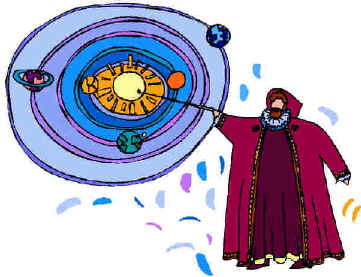|

|
Nicholas Copernicus (1473-1543)
disposed of the Earth as the Universe's center, by placing the Sun in
the central position, with the planets (including Earth) revolving
around the Sun. Although Copernicus tried to maintain some of the
Ptolemaic epicycles, his work marks a new era of the "Heliocentric"
theory. Tycho Brahe (1546-1601), financed by the King of
Denmark, used a wall quadrant and sextant that measured
star and planet locations accurately. This was modern equipment for
this time. He noticed that the stars were farther than previously
imagined.
Johannes Kepler (1571-1630)
using Tycho's records, developed 3 laws of planetary motion.
Kepler's laws outline that the orbit of planets are elliptical with
the Sun as the focus point; that planets revolve around the Sun over
equal areas; and there is a mathematical relationship of how far the
planets are from the Sun. Eyesight was still the most important tool
that humans had to explore the sky. |